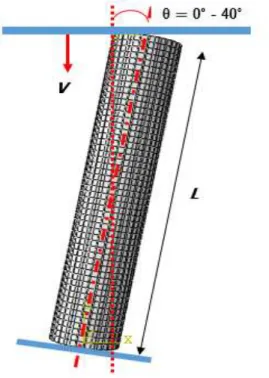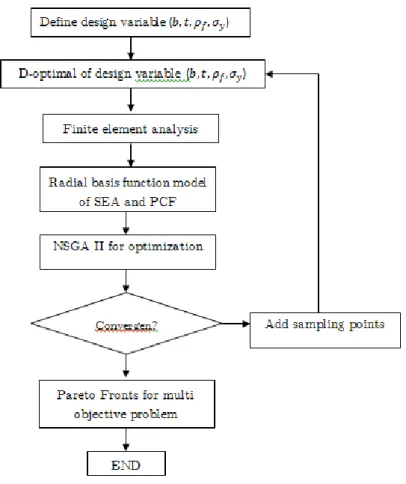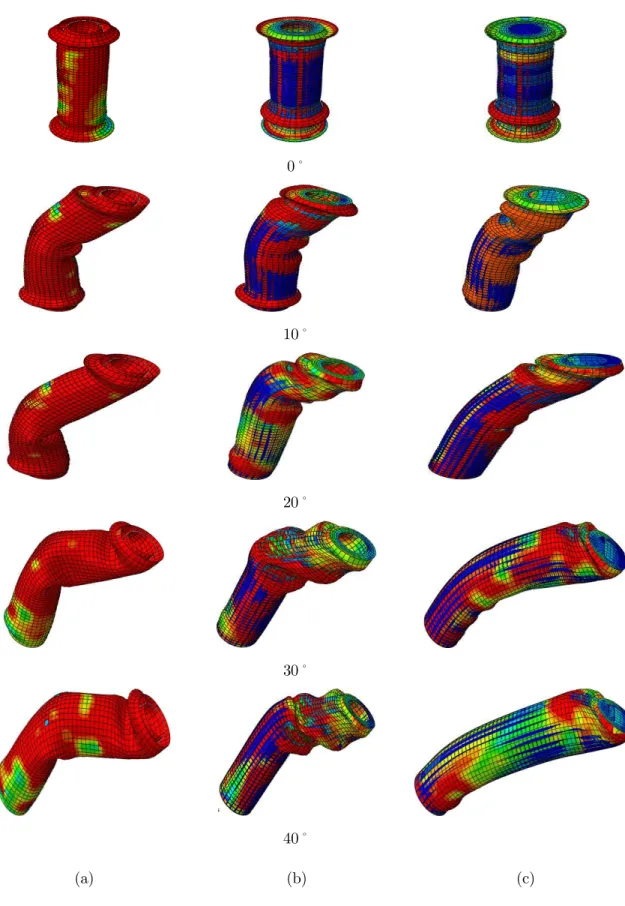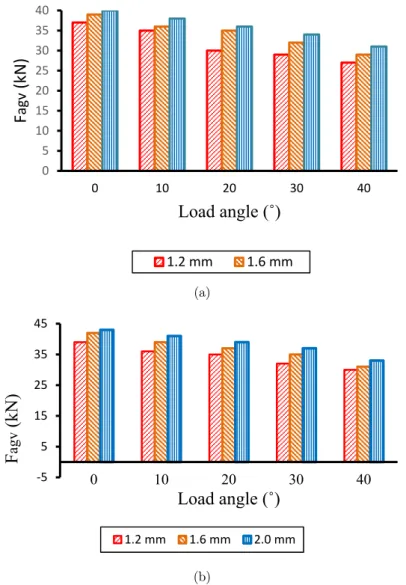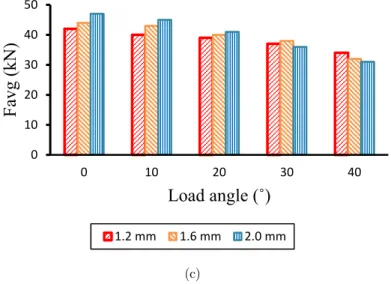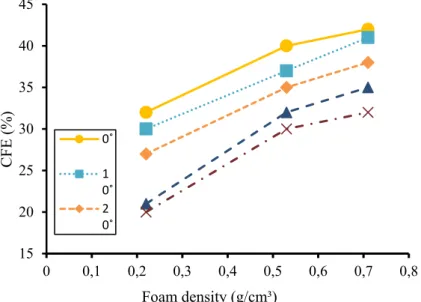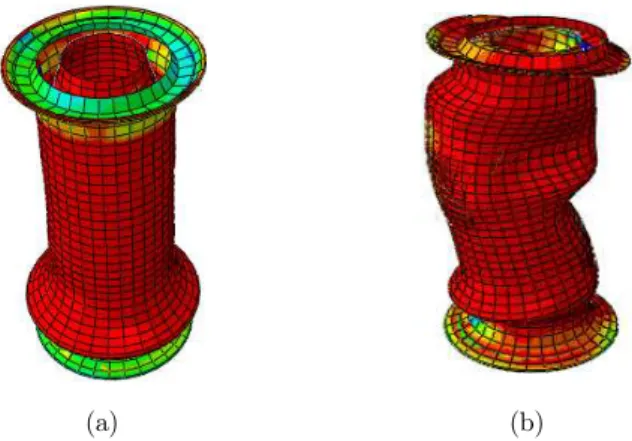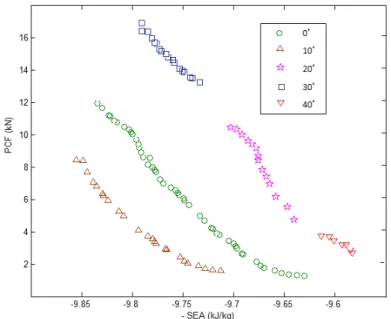Abstract
Finite element analysis and optimization design carry out for the quasi static responses of foam-filled double circular tube is pre-sented in this paper. In the investigation of the crashworthiness capability, some aspects were considered for variations in geome-try parameters of tubes and the loading condition to investigate the crashworthiness capability. Empty, foam-filled, and full foam-filled doublé tubes of thin walled structures were observed subjected to oblique impact (0˚ - 40˚). The numerical solution
was used to determine the crashworthiness parameters. In addi-tion, NSGA II and Radial Basis Function were used to optimize the crashworthiness capability of tubes. In conclution, the crash performaces of foam-filled double tube is better than the other structures in this work. The outcome that expected is the new design information of various kinds of cylindrical tubes for ener-gy absorber application.
Keywords
Aluminium foam, Crashworthiness, Cylindrical tube, Finite Element Analysis, Oblique impact, Optimization.
Finite Element Analysis and Crashworthiness Optimization
of Foam-filled Double Circular under Oblique Loading
1 INTRODUCTION
Foam-filled thin-walled structures have recently increased interest in the automotive industry be-cause of the great energy absorption capacity and extraordinary lightweight,. Huge research efforts have been carried out by various experiments (Gupta and Velmurugan, 1999; Hassen et al., 2000;
Fauzan Djamaluddin a,c,1 Shahrum Abdullah a,b,2 Ahmad K. Ariffin a,3 Zulkifli M. Nopiah a,4
a Department of Mechanical and
Materi-als Engineering, Universiti Kebangsaan Malaysia of Malaysia
b Center of Automotive Research,
Facul-ty of Engineering and Built Environ-ment, Universiti Kebangsaan Malaysia, 43600 UKM Bangi, Selangor, Malaysia
c Department of Mechanical Engineering,
Universitas Hasanuddin, Jl. Perintis Kemerdekaan, 90245, Makassar, Indone-sia.
1 fauzan@siswa.ukm.edu.my
2 shahrum@ukm.edu.my
3 kamal@ukm.edu.my 4 zmn@ukm.edu.my
http://dx.doi.org/10.1590/1679-78252844
Santosa et al., 2000; Borvik et al., 2003; Meguid et al., 2004; Reyes et al., 2004; Babbage and Mal-lick 2005; Mamalis et al., 2008; Rezadoust et al., 2008; Taher et al., 2009; Ghamarian et al. 2011; Niknejad et al., 2011; Kavi et al 2006; Seitzberger et al., 1997), analytical analyses (Gupta and Velmurugan, 1999; Taher et al., 2009; Wang et al., 2007), and numerical methods (Santosa et al., 2000; Reyes et al., 2004; Babbage and Mallick 2005; Rezadoust et al., 2008; Niknejad et al., 20113; Seitzberger et al., 1997; Ahmad et al., 2008, 2009; Ziaei‐Rad et al 2008; Santosa et al 2001 ).
The tube collapse more efficiently because the interaction between tube and filler might change the original collapse mode. Furthermore, some researchers (Seitzberger et al 1997, 2000; Yuen et al., 2008) used a double-cell profile arrangements with similar cross-section and the double tubes are empty or filled with aluminium foam to increase the energy absorption capabilities of thin-walled tubes,. In addition, Guo et al (2010a, 2010b, 2011) carried out the experiment and numerical simu-lation of the new topological structure i.e. double circular tubes under axial and three point bending conditions.
In the real vehicle collision event, a combination of the angle of impacting direction (or oblique/off-axis loads) is more occurred frequently and rarely encounters either fully axial or fully bending impact. Effects of oblique loading have been taken into account by Han and Park (1999). They found that angle of loading played an important role from axial progressive collapse mode to the global bending mode for square column subjected to oblique loads. In addition, Reyes et al. (2002, 2003, 2004) showed that the increasing of loading angle as the decreasing of the energy ab-sorption, in the case of the empty and foam-filled square columns under the quasi-static oblique loading conditions. Meanwhile, the energy absorption characteristics of tapered thin-walled rectan-gular tubes were explored by Nagel and Thambiratnam (2004, 2005, 2006). They concluded that the tapered tube better stability than straight tube when the oblique impact happen. Ahmad et al. (2010) focused on investigate the benefit of foam-filled conical tubes as vehicle energy absorber un-der oblique impact. Li et al (2012) studied the deformation and energy absorption of aluminum foam- filled double cylindrical tubes subjected to oblique loading and found that foam-filled double circular tube better crashworthiness capability than empty and foam-filled single circular tubes un-der quasi-static oblique loading.
There is limited design information about the double circular tube filled by foam, particularly under different angular impact. The aim of this paper is to determine the crushing behaviour and optimum values with respect to wall diameter, the wall thickness, and the foam density of the dou-ble circular tubes. Finite element models were validated by experiment and theory resulted in stud-ying the effect of parameters for different tubes, namely empty double tube, foam-filled double tube, and full foam-filled double tube. Finally, crashworthiness optimization of double circular tubes un-der different impact angular loading (0, 10, 20, 30 and 40 degree), which serve as guidelines for effi-cient design of foam-filled bitubal tubes.
2 DEVELOPMENT OF FINITE ELEMENT MODEL (FEM)
m/s in the Figure 1. The tubes cross-section is shown in Figure 2 and the outer and inner
thicknesses of the double tube walls were the same at 1.8 mm.
The finite element (FE) models of empty double tube, foam-filled double tube, and foam-filled single tube are shown in Fig. 3. The ABAQUS–Explicit was used to develop the aluminium foam-filled tubular tube models and to predict the response of thin-walled tubes that were impacted by a free falling impinging mass.
Figure 1: The schematic of bitubal circular tubes under oblique impact.
Figure 3: The Finite Element (FE) models of cylindrical tubes (a) empty double tube, (b) foam-filled double tube, and (c) full foam-filled tube.
Four node shell elements were used for tube walls and eight node continuum elements were used for foam. The element size is 2 mm based on a mesh convergence study of shells and foam elements. For all contact for instance the interaction between the foam and the tube walls, the cofficient value is 0.3
3 MATERIAL PROPERTIES
3.1 Thin-Walled Circular Double Tubes Material
The thin-walled tubes were made from aluminium alloy A6060 T4 with mechanical properties of density kg/m3, the Young’s modulus E = 68.2 GPa, the Poisson’s ratio v = 0.3 initial yielding stress y = 80 MPa, and ultimate stressu = 215.5 MPa. The pairs of the plastic strain and true stress were specified in Table 1 to accurately define the hardening characteristic in finite element models.
Plastic strain (%) 0.0 2.4 4.9 7.4 9.9 12.4 14.9 17.4
Plastic stress (Mpa) 80 115 139 150 158 167 171 173
Table 1: Strain hardening data for A6060 T4.
3.2 Aluminium Foam Filled Material
4 CRASHWORTHINESS INDICATOR
To evaluate the energy-absorbance of structures, it is necessary to define the crashworthiness indi-cators. The parameters, such as Energy Absorption (EA), SEA, and PCF, can efficiently evaluate the crashworthiness of structures. Energy absorption can be calculated as:
(1)
where, F(x) is the instantaneous crashing force with a function of the displacement δ. SEA indicates the absorbed energy (EA(δ)) per unit mass (M) of a structure as:
(2)
where, Mtotal is the structure’s total mass. In this case, a higher value indicates the higher energy absorption efficiency of a material.
The average crush force (Favg) is the response parameter for the energy absorption capability:
(3)
where, energy is absorbed (EA(δ)) during collapse and displacement (δ).
Crush force efficiency is defined as the ratio of the average crush force (Fagv) to the peak crush force (Fmax),
x % (4)
Peak crush force (Fmax) is important indicator in the design of energy absorption structures to
absorb the impact energy in collision.
5 CRASHWORTHINESS OPTIMIZATION
The surrogate model (Radial Basis Functions (RBF)) and D-Optima were choosed for the relation-ships between the individual objective functions and the design variable vector. Non-dominated sorting GA (NSGA) II was choosed because a more effective and efficient algorithm for ranking the solution, assigning ranking fitness, and benchmarking number problems. Figure 4 shows the imple-mentation of multi objective optimization for the empty and foam-filled double cylindrical tubes. All the optimization designs were developed by MATLAB.
6 MODEL VALIDATION
numeric simulation and experiment result were carried out the comparison between the numerical simulation and the experiment result and demonstrated of foam-filled double cylindrical tube sub-jected to quasi-static loading (Li et al., 2012).
Figure 4: Flowchart of the optimization of tubes under oblique impact loading.
7 RESULT AND DISCUSSION
7.1 Deformation Modes
0˚
10˚
20˚
30˚
40˚
(a) (b) (c)
7.2 Effect of Thickness
Figure 6 show the effect of tube wall thickness and angle of loading are assessed to determine the mean crushing force from progressive collapse to bending collapse of tube. Mean crushing force is calculated with displacement of 120 mm for each tubes. It is expected that the mean crushing force (Favg) decrease with increase angle of load. The wall thickness of tube increase give effect to Fagv value in different loading angle. But, the FD tube under 30˚ And 40˚ decrease wall thickness of tube can be increase Fagv. Normally, the mean crushing force the in progressive collapse more sensi-tive compared to bending collapse. Furthermore, the increasing of load angle is more important when the large of wall thickness which it can be reduce the SEA and Fagv value (Qi et al. 2012).
(a)
(b)
Figure 6: Effect of wall thickness on mean crushing force of (a) ED, (b) FD.
F
agv
kN
Load angle (˚)
. mm . mm
‐ 0 10 20 30 40
F
agv
(kN)
Load angle (˚)
(c)
Figure 6 Cont.: Effect of wall thickness on mean crushing force of (c) DD with different load angle.
7.3 Effect of Diameter
Figure 7 shows the effect of different diameter (d) of the tube wall in response to a quasi-static pa-rameter such as specific energy absorption (SEA) each tube configuration. The results indicated that EA is more sensitive in progressive collapse than bending collapse on the diameter of the tube wall responses. However, the SEA does not have a significant impact on increasing of tube diameter and angle of loading for the two types of progressive collapse and global bending. Furthermore, it is interesting to be noted that the reduction in energy absorption and specific energy absorption are caused with increasing the load angle. This is also in contrast to the case with the increase in wall thickness as shown previously.
Figure 7: Effect of diameter on SEA in different load angle.
Favg (kN)
Load angle (˚)
. mm . mm . mm
0 10 20 30 40 50
SEA
(kJ/kg)
Load angle (˚)
7.4 Effect of Foam Density
Figure 8 and 9 show the effect of varying density foam on the quasi-static response such as the crushing energy efficiency (CFE) under axial load (0˚) and oblique (10˚ - 40˚). In general, increas-ing the density of the foam effect crusher energy efficiency significantly by loadincreas-ing different angle. It notes that the CFE is less with low-density foam (0.22 g / cm3) of the tube is filled with high densi-ty foam (0.534 and 0.71 g / cm3). Ahmad and Thambiratnam (2009) studied the densidensi-ty of the foam is an important thing and it has an effect that can be used as a parameter to control the crashworthines characteristics and behavior of thin-walled tubes.
Figure 8: Effect of foam density of FD on SEA in different load angle.
Figure 9: Effect of foam density of DD on SEA in different load angles.
, , , , , , , ,
CFE (%)
Foam density (g/cm³) ˚
˚ ˚ ˚ ˚
15 20 25 30 35 40 45
0 0,1 0,2 0,3 0,4 0,5 0,6 0,7 0,8
CFE (%)
Foam density (g/cm³) ˚
˚
7.5 Effect of Geometrical Imperfection
To read the buckling modes of the inner and outer tubes placed between two rigid wall. The imper-fection is used in ABAQUS/Explicit. Figure 10 show that the simulations have initial geometrical imperfection and without and it is evident that the collapsing shape of the tubes by sufficient accu-racy.
(a) (b)
Figure 10: Collapsing mode of empty doublé tubes (ED) under axial quasi-static load (a) with initial geometrical imperfection and (b) without.
7.6 Optimization Design of Double Tubes (FD) Under Oblique Impact
In this section, the double foam filled tube are optimized under five impact angles 0°, 10°, 20°, 30° and 40°. The optimization problem can be written as the following:
, , , , , , ,
. .
. .
/ /
(5)
Figure 11 shows the Pareto fronts of PCF against SEA for double circular foam filled tubes un-der five different impact angles. In addition, two objective SEA and PCF conflict with each other for all design cases. It can be seen that any increase in SEA always leads to an undesirable increase in PCF, and vice versa. From 0° to 30°, the Pareto front gradually moves to the top-left region as the impact angle increases indicating that both PCF and SEA decrease with an increase of impact angle.
8 CONCLUSIONS
us-ing finite element simulations. Energy absorption response was quantified with respect to variations in the parameter of foam density, wall thickness and diameter of tube.
Figure 11: Pareto fronts for double circular foam filled (FD) tubes under four different impact angles.
This paper has observased the crush response and energy absorption of three different cross sec-tion of circular tubes namely empty-empty tube, empty foam filled tube and foam filled-foam filled double cylindrical tubes under axial compression and oblique impact loadings. The computer simu-lations, validated by experiments and theory, have been used to obtain an insight into the oblique crush response and quantify the energy absortion, specific energy absorption and peak crushing force for variations in the load angle, wall thickness, foam density and length of tubes. The main conclusion is that full foam filled double circular tubes were found to be effective energy absorbing devices since they can withstand an oblique impact load as effectively as an axial compression and bending mode to reduct the energy absorption as crashworthiness structures.
Finally, the optimization design of foam filled doublé tuve under multiple impact angles have been investigated. By maximizing the specific energy absorption and minimizing the peak crushing force simultaneously under different impact angles, so multi optimization problem is considered. It is found that the optimal design highly depends on the given impact angle for FD and it conclude that FD has much better crashworthiness capacity and it can be recommended as an efficient ener-gy absorber for vehicles
References
Ahmad, D.P. Thambiratnam, A.C.C. Tan, A numerical study on the axial loading and energy absorption of foam‐ filled conical tubes, Proceedings of the 7th International Conference on Shock & Impact Loads on Structures, (2007) 99‐106.
Ahmad, D.P. Thambiratnam, Crushing response of foam‐filled conical tubes under quasi‐static axial loading, Mater Design, 30 (2009) 2393‐2403.
Ahmad Z, Thambiratnam DP, Tan ACC. Dynamic energy absorption characteristics of foam-filled conical tubes under oblique impact loading. Int J Impact Eng 2010;37:475-88.
Babbage J.M, P.K. Mallick, Static axial crush performance of unfilled and foam‐filled aluminum‐composite hybrid tubes, Compos Struct, 70 (2005) 177‐184.
Borvik T, O.S. Hopperstad, A. Reyes, M. Langseth, G. Solomos, T. Dyngeland, Empty and foam‐filled circular alu-minium tubes subjected to axial and oblique quasi‐static loading, Int J Crashworthines, 8 (2003) 481‐494.
Deshpande, N.A. Fleck, Isotropic constitutive models for metallic foams, J Mech Phys Solids, 48 (2000) 1253‐1283. Djamaluddin, S. Abdullah, A.K. Ariffin, Z.M. Nopiah. Optimization of foam-filled double circular tubes under axial and oblique impact loading conditions. Thin-walled structures. 87 (2015) 1–11.
Djamaluddin, S. Abdullah, A.K. Ariffin, Z.M. Nopiah. Multi objective optimization of foam-filled tubular circular tubes for quasi-static and dynamic responses. Latin american journal solid and structure, 2015
Djamaluddin, S. Abdullah, A.K. Ariffin, Z.M. Nopiah. Multi Objective Optimization of Aluminum Foam Filled Double Tubes Subjected to Oblique Impact Loading for Automobile Bumper Beam, Applied Mechanics and Materi-als Vol. 663 (2014) pp 93-97
Gupta NK, R. Velmurugan, Axial compression of empty and foam filled composite conical shells, J Compos Mater, 33 (1999) 567‐591.
Ghamarian, H.R. Zarei, M.T. Abadi, Experimental and numerical crashworthiness investigation of empty and foam‐ filled end‐capped conical tubes, Thin Wall Struct, 49 (2011) 1312‐1319.
Guo LW, Yu JL, Li ZB. Experimental studies on the quasi-static bending behavior of double square columns filled with aluminum foams. Acta Mech 2010;213:349–58.
Guo LW, Yu JL. Experimental studies on the quasi-static axial crushing behavior of double square columns filled with aluminum foams. J Exp Mech 2010;25(3):271–8.
Guo LW, Yu JL. Dynamic bending response of double cylindrical tubes filled with aluminum foam. Int J Impact Eng 2011;38(2–3):85–94.
Han DC, Park SH. Collapse behavior of square thin-walled columns subjected to oblique loads. Thin-walled Struct 1999;35:167–84.
Hanssen A.C, M. Langseth, O.S. Hopperstad, Static and dynamic crushing of circular aluminium extrusions with aluminium foam filler, Int J Impact Eng, 24 (2000) 475‐507.
Kavi, A.K. Toksoy, M. Guden, Predicting energy absorption in a foam‐filled thin‐walled aluminum tube based on experimentally determined strengthening coefficient, Mater Design, 27 (2006) 263‐269.
Li ZB, Yu JL, Guo LW. Deformation and energy absorption of aluminium foam- filled tubes subjected to oblique loading. Int J Mech Sci 2012:48–56.
Mamalis A. G, D.E. Manolakos, M.B. Ioannidis, K.N. Spentzas, S. Koutroubakis, Static axial collapse of foam‐filled steel thin‐walled rectangular tubes: experimental and numerical simulation, Int J Crashworthines, 13 (2008) 117‐126. Meguid S.A, M.S. Attia, A. Monfort, On the crush behaviour of ultralight foam‐filled structures, Mater Design, 25 (2004) 183‐189.
Nagel G, Thambiratnam D. A numerical study on the impact response and energy absorption of tapered thin-walled tubes. Int J Mech Sci 2004;46:201-16.
Nagel G, Thambiratnam D. Computer simulation and energy absorption of tapered thin-walled rectangular tubes. Thin-wall Struct 2005;43:1225-42.
Niknejad, G.H. Liaghat, H.M. Naeini, A.H. Behravesh, Theoretical and experimental studies of the instantaneous folding force of the polyurethane foam‐filled square honeycombs, Mater Design, 32 (2011) 69‐75.
Reyes A, O.S. Hopperstad, M. Langseth, Aluminum foam‐filled extrusions subjected to oblique loading: experimental and numerical study, Int J Solids Struct, 41 (2004) 1645‐1675.
Reyes A, Langseth M, Hopperstad OS. Crashworthiness of aluminum extrusions subjected to oblique loading: exper-iments and numerical analyses. Int J Mech Sci 2002;44(9):1965–84.
Reyes A, Langseth M, Hopperstad. OS. Square aluminum tubes subjected to oblique loading. Int J Impact Eng 2003;28(10):1077–106.
Reyes A, Hopperstad OS, Langseth M. Aluminum foam-filled extrusions subjected to oblique loading: experimental and numerical study. Int J Solids Struct 2004;41(5–6):1645–75.
Rezadoust A. M, M. Esfandeh, S.A. Sabet, Crush behavior of conical composite shells: Effect of cone angle and di-ameter/wall thickness ratio, Polym‐Plast Technol, 47 (2008) 147‐151.
Santosa S.P, T. Wierzbicki, A.G. Hanssen, M. Langseth, Experimental and numerical studies of foam‐filled sections, Int J Impact Eng, 24 (2000) 509‐534.
Santosa, J. Banhart, T. Wierzbicki, Experimental and numerical analyses of bending of foam‐filled sections, Acta Mech, 148 (2001) 199‐213.
Seitzberger, F.G. Rammerstorfer, H.P. Degischer, R. Gradinger, Crushing of axially compressed steel tubes filled with aluminium foam, Acta Mech, 125 (1997) 93‐105.
Seitzberger M, F.G. Rammerstorfer, R. Gradinger, H.P. Degischer, M. Blaimschein, C. Walch, Experimental studies on the quasi‐static axial crushing of steel columns filled with aluminium foam, Int J Solids Struct, 37 (2000) 4125‐ 4147.
Shahbeyk S, Spetrinic N, Vafai A. Numerical modelling of dynamically loaded metal foam-filled square columns. IntJ Impact Eng2007;34:573–86.
Taher, R. Zahari, S. Ataollahi, F. Mustapha, S. Basri, A double‐cell foam‐filled composite block for efficient energy absorption under axial compression, Compos Struct, 89 (2009) 399‐407. 23
Wang, Z.J. Fan, L.J. Gui, Theoretical analysis for axial crushing behaviour of aluminium foam‐filled hat sections, Int J Mech Sci, 49 (2007) 515‐521.
Yuen S, Chung Kim, Nurick GN, Starke RA. The energy absorption characteristics of double-cell tubular profiles. Lat Am J Solids Struct 2008 ; 5(4) : 289–317.
